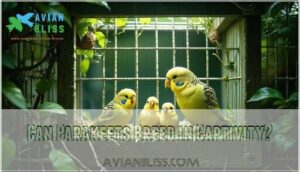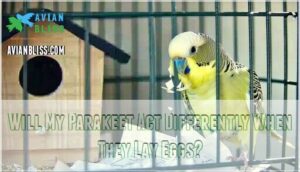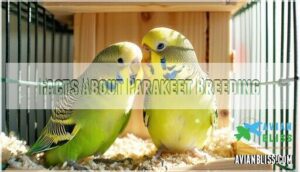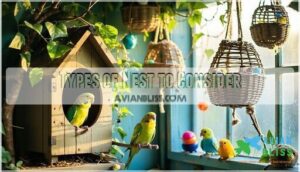This site is supported by our readers. We may earn a commission, at no cost to you, if you purchase through links.
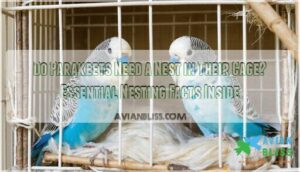
Since parakeets won’t build their own nests, you’ll need to provide one. A nesting box is essential for breeding parakeets, where they can lay and protect their eggs.
You’ll want to choose the right type of nest for your parakeet’s needs. There are different types of nests to examine, and understanding their purposes will help you create a comfortable environment for your pet.
Learn more about the best nesting options for your parakeet.
Table Of Contents
- Key Takeaways
- Do Parakeets Need a Nest in Their Cage
- Parakeets and Nesting
- Can Parakeets Breed in Captivity?
- What Do Parakeets Need for Nesting?
- Will My Parakeet Act Differently When They Lay Eggs?
- Facts About Parakeet Breeding
- Types of Nest to Consider
- Parakeet Breeding Box or Nesting Box
- Frequently Asked Questions (FAQs)
- Do parakeets build nests?
- Do parakeets lay eggs in a nesting box?
- Can parakeets breed in activity?
- Do parakeets need a hut?
- Are parakeets good pets?
- Do parakeets sleep?
- Do parakeets need a nest?
- What does a parakeet need in its cage?
- Can parakeets breed without a nesting box?
- Can parakeets live without another bird?
- Conclusion
Key Takeaways
- You don’t need a nest for your parakeet’s survival – pet parakeets can live happily without nests, but they provide comfort and security for resting and privacy.
- Nests are essential if you’re planning to breed – parakeets won’t build their own nests, so you’ll need to provide a proper breeding box for egg-laying and chick-rearing.
- Choose the right type based on your goals – use sleeping/play nests for comfort and enrichment, or specialized breeding boxes if you want your parakeets to reproduce.
- Proper setup matters for success – place nests in quiet, secure areas with soft materials like coconut fiber or pine shavings, and maintain regular cleaning for hygiene.
Do Parakeets Need a Nest in Their Cage
You may wonder if your parakeet needs a nest in its cage for comfort or breeding.
Parakeets require a proper nest or sleeping area to feel safe, rest well, and, if breeding, to lay eggs securely.
Sterilized Coconut Fiber Bird Nesting Material
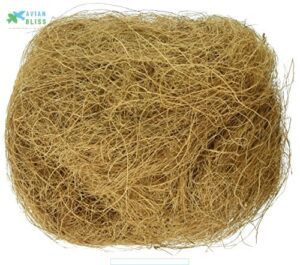
In the context of providing your parakeet a nest that feels just right, sterilized coconut fiber is a smart pick.
As it mimics their natural home, it also checks all the boxes for comfort and safety.
Here’s why coconut fiber stands out for parakeet nesting:
- Coconut Fiber Benefits: Soft, natural, and gentle on tiny feet.
- Fiber Nest Hygiene: Sterilized to keep bacteria and pests away.
- Fiber Texture Preference: Parakeets love the cozy, tangle-free feel.
- Fiber Nest Longevity: Stays fresh longer than many other bird nesting materials.
Place the coconut fiber nest in a quiet spot and watch your bird settle right in.
Sukh Bird Nesting Material Mix

If you want your parakeet to feel right at home, the Sukh Bird Nesting Material Mix is worth considering.
It’s made from natural fibers like jute silk, hemp rope, and cotton, so your bird gets a soft material that’s safe for bedding.
Plus, it’s dust-free, which means fewer sneezes and easier cleaning.
This mix shapes easily, fitting any parakeet nest or cage setup.
Hygiene factors matter, and this mix helps keep things tidy.
Here’s a quick look:
| Feature | Benefit | Why It Matters |
|---|---|---|
| Natural Fibers | Safe Bedding | Healthier birds |
| Dust-Free | Easy Cleaning | Less mess |
| Soft Material | Comfort | Happy parakeets |
Parakeet Nesting Box Bird House
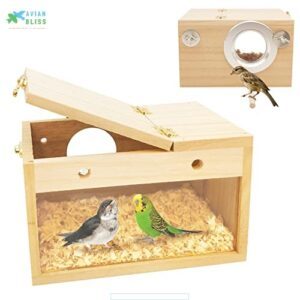
If you’re thinking about giving your parakeet a real sense of home, a Parakeet Nesting Box Bird House fits the bill.
It should be the right nesting box size—big enough for comfort, but not so large your bird feels lost.
Use only bird-safe materials to avoid health risks.
Place the box in a quiet corner of the parakeet cage, away from drafts.
Clean it weekly to keep things fresh, and to encourage acceptance, add soft bedding.
A good parakeet nest helps with parakeet nesting and even breeding.
Parakeet Nesting Box Natural Wood
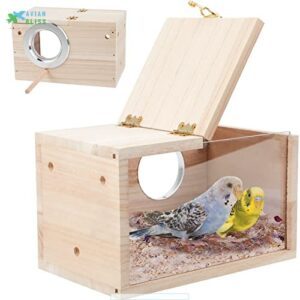
If you’re after a parakeet nest that feels just right, a parakeet nesting box made of natural wood is a smart pick.
The Wood Durability stands up to daily use, while Natural Safety keeps your birds healthy. Plus, it taps into your parakeet’s Nesting Instincts, making them feel at home.
With the right Size Matters for comfort and Cleaning Ease for you, it’s a win-win.
Here’s what you get:
- Secure, natural wood for safety
- Easy-to-clean design
- Transparent side for simple observation
Parrot Nesting Box

After exploring natural wood options, let’s talk about the parrot nesting box—a smart pick for your parakeet nest needs.
This nesting box is built for safety and privacy, using bird-safe materials and a comfortable box size.
The transparent side lets you check on your birds without causing stress.
Place the box inside or outside the cage, wherever your birds feel most secure.
Cleaning is easy thanks to the hinged lid.
With proper box placement and observation features, you’ll support healthy parakeet nesting and happy bird nests.
Parakeets and Nesting
A good nest is like a cozy hideaway for your parakeet, offering both privacy and comfort. In the wild, these birds look for safe tree hollows to settle down.
A nest transforms a simple cage into a safe retreat where your parakeet truly feels at home.
At home, your parakeet depends on you for a proper parakeet cage setup. Nest Purpose matters—nests aren’t just for breeding but also for sleep and security.
Use soft Nest Materials, like pine shavings or shredded paper, to mimic Wild Nesting habits. Keep an eye on Nest Hygiene by cleaning often to prevent health issues.
When nesting, you might see new behaviors—shredding paper, getting territorial, or spending more time in the nest. This is all part of their natural nesting habits and helps with Chick Development.
- A soft, lined nest box tucked in a quiet cage corner
- Shredded paper scattered for natural bird nesting
- A mother bird gently tending her eggs
Can Parakeets Breed in Captivity?
Creating the right breeding conditions in captivity can make all the difference for parakeet breeding success. You’ll need to think about more than just a nesting box or breeding box.
Set up the cage so your birds feel safe and private. Privacy is key—without it, parakeets often won’t lay eggs or will abandon them. It’s like giving them their own cozy apartment, away from the hustle and bustle.
Don’t forget that parakeets need enrichment to stay healthy and stimulated during this time. Don’t forget about genetic considerations and ethical implications, too.
Breeding challenges can include aggression and the need for population control, so monitor your birds closely.
| Breeding Conditions | Genetic Considerations | Ethical Implications |
|---|---|---|
| Private space, proper lighting, diet | Avoid inbreeding, maintain healthy lines | Prevent overbreeding, guarantee bird welfare |
Supporting your parakeets’ natural instincts while managing cage setup keeps both the birds and their future chicks safe and healthy.
What Do Parakeets Need for Nesting?
Understanding what your parakeets need for successful nesting guarantees their comfort and breeding success.
Creating the right environment involves several key considerations that directly impact their nesting behavior and overall well-being.
Essential Nesting Requirements:
- Nest Materials – Provide soft bedding like pine chips, shredded paper, or coconut fiber for insulation and comfort during egg incubation.
- Nest Size – Choose a breeding box measuring approximately 6 inches in diameter with adequate space for movement and egg-laying.
- Nest Placement – Position the nesting box in a quiet, secure area of the cage to minimize stress and disturbances.
- Nest Hygiene – Regularly change bedding materials while respecting their privacy during breeding periods to maintain cleanliness.
- Nest Purpose – Distinguish between sleeping huts for comfort and specialized breeding boxes designed for egg protection and chick-rearing.
Proper parakeet nesting setup mimics their natural tree hollow preferences, encouraging natural behaviors while guaranteeing safety for both parents and potential offspring.
To prevent issues, consider safe nesting materials like pine wood shavings.
Will My Parakeet Act Differently When They Lay Eggs?
When your parakeet gears up for egg-laying, you’ll spot clear bird behavior changes.
Watch for behavioral changes as egg-laying approaches
Watch for pre-laying behavior like shredding paper or rearranging things in her cage. Aggression levels can spike as she guards her space, and vocalization changes might catch your ear—she may chirp more or less.
Hormonal shifts drive these breeding behaviors. After laying parakeet eggs, post-laying changes include periods of rest and less activity.
- Expect increased protectiveness around the nest during this bird egg laying phase.
Facts About Parakeet Breeding
Every bird breeder knows timing is everything. Your parakeet reaches breeding age at about 10 months, but don’t rush things—early breeding can lead to issues.
Mating rituals include beak tapping and head-bobbing, while the female lays eggs every other day. Egg incubation lasts around 18 days, and chick development takes about five weeks.
Breeding seasonality peaks in spring and summer. A proper nesting box or breeding box lined with soft material is key for safe parakeet breeding and successful bird breeding.
Captive parakeets, however, can breed year-round if provided with abundant food and water, impacting their parakeet breeding habits.
| Fact | Detail |
|---|---|
| Breeding Age | 10+ months |
| Mating Rituals | Beak tapping, bobbing |
| Egg Incubation | 17-20 days |
| Chick Development | ~5 weeks |
| Seasonality | Spring/Summer |
Types of Nest to Consider
When choosing a nest for your parakeet, you need to think about their main needs, such as rest or breeding.
There are different types of nests, including sleeping and play nests for comfort, and breeding nests for egg-laying and privacy.
Sleeping and Play Nests
After learning about breeding, let’s talk about where your parakeet actually sleeps and plays. Most prefer the highest perch for bird sleep, not a nest box.
For parakeet comfort and enrichment, try these:
- Cozy huts made from safe Hut Materials for Privacy Needs
- Soft rope perches or plush Bedding Options
- Chewable toys for Chewing Instincts and Mental Stimulation
These support natural parakeet behavior and keep them happy. Many owners find that safe bird huts provide comfort.
Breeding Nests
When you’re ready for parakeet breeding, the right breeding nest is key.
A proper parakeet breeding box guarantees privacy, helps with egg incubation, and supports chick development.
Make sure you choose a nest box size that fits your pair and is made from safe, bird-friendly materials.
Breeding triggers, like extra daylight and the right parakeet nesting materials, help your birds feel at home.
You can even find a parakeet breeding box online.
For best results, consider these options:
- Closed nest boxes for privacy and easy cleaning
- Open rope nests for observation
- Sleeping huts for extra comfort
- Natural hideaways to mimic wild parakeet nesting habits
Parakeet Breeding Box or Nesting Box
When you’re thinking about nesting options, a parakeet breeding box is the top pick for safe, successful breeding. Size matters here—aim for a box about 12 by 8 by 8 inches.
Use sturdy box materials like natural hardwood or untreated wood for safety and comfort. Place the nesting box where your birds feel secure and out of drafts, but still easy for you to reach.
Cleaning frequency is important; wipe down the box with a vinegar-water mix before breeding starts and swap out bedding every couple of days while chicks are in the nest. Aspen shavings are best, but avoid pine or cedar.
If breeding isn’t your goal, nesting alternatives like sleeping huts or play nests can provide comfort. You can find a suitable breeding box online.
A well-chosen breeding box helps your parakeets feel at home and ready to raise healthy chicks.
Frequently Asked Questions (FAQs)
Do parakeets build nests?
You’ll find that parakeets don’t build nests themselves, instead, they require a suitable space or nesting box provided by their owner for breeding, resting, and feeling secure.
Do parakeets lay eggs in a nesting box?
You’ll find that parakeets do lay eggs in a nesting box, which provides a safe and secure environment for them to breed and raise their young.
Can parakeets breed in activity?
You can breed parakeets in captivity with sufficient space and nesting boxes, they thrive when given privacy and specific environmental conditions to mate and raise their young successfully.
Do parakeets need a hut?
You should provide a hut for your parakeet as it offers a sense of security and comfort, mimicking their natural nesting habits and providing a cozy place to rest.
Are parakeets good pets?
You’ll love having parakeets as pets, they’re colorful, social, and entertaining, making them a great companion for you.
Do parakeets sleep?
You’ll notice parakeets sleep a lot, typically 10-12 hours daily, often in short naps, and they prefer a cozy, dark place to rest.
Do parakeets need a nest?
You’ll find that parakeets need nests for privacy, resting, and breeding, offering a safe and secure environment for them to thrive in their own space.
What does a parakeet need in its cage?
Like a cozy little home, your parakeet needs a spacious cage with a warm bed and nesting area for comfort and security.
Can parakeets breed without a nesting box?
Parakeets can breed without a dedicated nesting box, but they’ll likely lay eggs on the cage floor.
This reduces hatching success since eggs need protection and warmth.
You’ll get better breeding results with a proper nest box.
Can parakeets live without another bird?
Yes, parakeets can absolutely live alone and often thrive as single birds.
While they’re social creatures, solo parakeets bond closely with their owners and can live happy, healthy lives with proper attention, interaction, and mental stimulation from you.
Conclusion
Whether your parakeet needs a nest depends on your specific situation.
Do parakeets need a nest in their cage? Yes, if you’re planning to breed them or want to provide a cozy retreat for comfort.
However, pet parakeets don’t require nests for survival.
Choose sleeping nests for relaxation or breeding boxes for egg-laying.
Consider your bird’s behavior, available space, and breeding intentions.
The right nest creates a secure environment where your parakeet can rest, hide, and potentially raise young if that’s your goal.
- https://www.quora.com/What-is-a-nest-box-and-do-parakeets-need-one
- https://www.omlet.us/guide/parakeets/nesting_and_breeding/
- https://lafeber.com/pet-birds/questions/parakeet-breeding/
- https://www.reddit.com/r/Parakeets/comments/rxu9lk/best_cage_setup_for_a_parakeet/
- https://www.petco.com/content/content-hub/home/articlePages/behavior-training/parakeet-breeding.html

